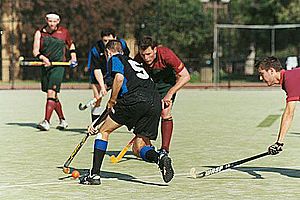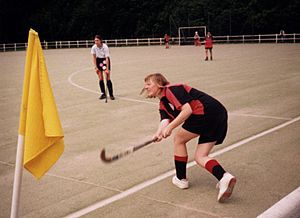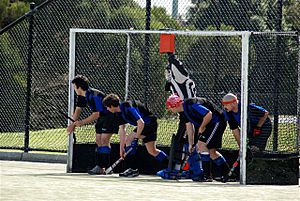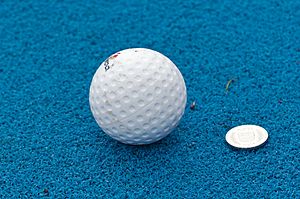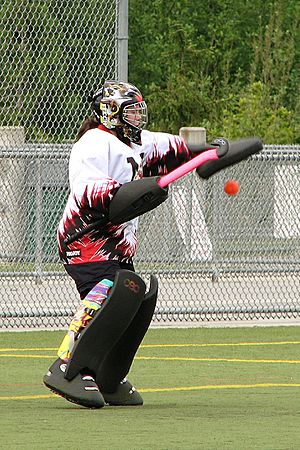Field hockey facts for kids
Field Hockey is a popular sport played by both men and women in many countries around the world. It's a fast-paced team game that requires skill and teamwork.
Two teams play against each other, with 11 players on each team. The game is divided into four 15-minute periods. There's a 15-minute break at halftime and shorter 2-minute breaks after the first and third periods.
Field hockey can be played on natural grass, or on special artificial fields made of sand or water-based turf. A small, hard ball is used in the game.
The playing field is shaped like a rectangle, with a goal at each end. A special area, called the shooting circle, is about 15 meters from each goal. Goals can only be scored when the ball is hit from inside this shooting circle.
The hockey stick is J-shaped and usually made from wood, glass, and fibre. It has a curved hook at the end to control the ball.
Player positions are similar to soccer. Teams have fullbacks (defenders), halfbacks (midfielders), and forwards (attackers). Each team also has a special player called the goalkeeper. Goalkeepers try to stop the other team from scoring goals.
For safety, every player must wear shin guards to protect their shins and a mouth guard to protect their teeth.
Contents
How Field Hockey is Played
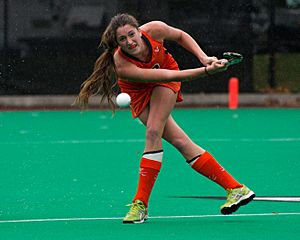
In field hockey, players on the team with the ball are called attackers. Players on the team without the ball are called defenders. However, during the game, all players are always trying to defend their own goal and attack the opponent's goal.
Two umpires control the match. Each umpire usually watches one half of the field. They are often helped by a timekeeper and a record keeper.
Before the game starts, a coin is tossed. The winning captain chooses which end to start from or if their team will start with the ball. Since 2017, games have four 15-minute periods. There are 2-minute breaks after the first and third periods, and a 15-minute break at halftime. Teams switch sides at halftime.
Play starts from the center of the field at the beginning of each period and after a goal is scored. All players must be in their defensive half, except for the player starting the game. The ball can be passed in any direction. The team that had a goal scored against them gets to restart the game.
Field players can only hit the ball with the flat, front side of their stick. If they use the back side, it's a penalty, and the other team gets the ball. Players can tackle (try to take the ball) as long as they don't hit the opponent or their stick before touching the ball. Players with the ball cannot use their body to push defenders away.
Players cannot intentionally touch the ball with their feet. If the ball accidentally hits a player's foot and they don't gain an advantage, it's usually not a penalty.
Obstruction happens when a player blocks an opponent from getting to the ball. This can be by putting their body or stick between the opponent and the ball. It also happens if a player blocks an opponent from tackling a teammate who has the ball.
When the ball goes completely over the sidelines, it's brought back into play with a "sideline hit." The hit is taken by a player from the team that didn't touch the ball last. The ball must be placed on the sideline where it went out. If an attacking player hits the ball over the back line, the defending team gets a "15-meter hit." This hit is also given for fouls committed by the attacking team within 15 meters of the goal line.
Game Strategies
A basic strategy in field hockey is to have more players than the opponent in a certain area of the field. When your team has the ball, this helps pass the ball around defenders. It also creates space for shots on goal. When the other team has the ball, having more players helps to surround an opponent and win the ball back.
Every player has a specific role depending on where the ball is. Players communicate to support each other.
Players move the ball using different techniques:
- Passing: Sending the ball to a teammate.
- Pushing: Moving the ball along the ground while running with it.
- Dribbling: Controlling the ball with the stick while moving in different directions to avoid opponents.
To pass, players can use a "pushing stroke" by pushing the stick head through the ball. A "flick" or "scoop" is similar but lifts the ball off the ground. A "hit" involves swinging the stick forcefully at the ball, sending it very fast, sometimes over 70 miles per hour. A powerful hit for long distances or shots on goal is called a "drive."
Tackles are made by placing the stick in the ball's path or hitting the ball directly with the stick. Players often lay their stick flat on the ground to create a wider barrier. To avoid a tackle, the ball carrier can pass the ball or try to dribble around the defender.
The penalty corner has become very important for scoring goals. This is especially true with the development of the "drag flick" shot. Penalty corners often involve complex plays with multiple passes before a shot or a deflection towards the goal. The most common way to score is a direct flick or hit.
At the highest level, field hockey is a very fast and skilled game. Players use quick stick moves, accurate passes, and hard hits to keep the ball and move it towards the goal. Physical contact and blocking opponents are not allowed. Some strategies are similar to soccer, but the ball moves much faster.
Equipment Used in Field Hockey
Field Hockey Stick
Each player uses a "stick" that is usually between 80–95 cm (31–38 inches) long. Sticks were traditionally made of wood. Now, they are often made from fiberglass, kevlar, or carbon fiber composites. Metal is not allowed in sticks because of the risk of injury if the stick breaks.
The stick has a round handle and a J-shaped hook at the bottom. The left side of the stick (when looking down the handle) is flat. All sticks must be "right-handed"; left-handed sticks are not allowed.
The handle is about the top third of the stick. It's covered with a grip, similar to a tennis racket grip. Some players use chamois leather for better grip when wet.
Recently, sticks were designed with a deeper curve (called the bow) on the flat side. This made it easier to get high speeds from the drag flick shot. Rules now limit this curve to under 25 mm to control the power of the flick.
Field Hockey Ball
Standard field hockey balls are hard, round balls made of plastic. They sometimes have a cork center. Balls are usually white, but they can be any color that stands out from the playing field. They are about 71.3–74.8 mm (2.8–2.9 inches) in diameter and weigh 156–163 grams (5.5–5.7 ounces). The ball often has small indentations (dimples) to help it move consistently on wet surfaces.
Goalkeeping Gear
Goalkeepers wear a lot of protective equipment. This includes a helmet, leg guards, and kickers (foot protectors). They also usually wear chest guards, padded shorts, thick hand protectors, groin protectors, neck guards, and arm guards. Like all players, they carry a stick.
A goalkeeper cannot cross the 23-meter line on the field. The only time they can leave this area is if they need to take a penalty stroke at the other end of the field. If they do this, they can remove their helmet. However, if they choose to wear only a helmet (and a different colored shirt), they can cross the 23-meter line if they take their helmet off and place it safely off the field. If play returns to the circle before they can put their helmet back on, they still have "goalkeeping privileges." This means they can use their feet and hands to play the ball while it's in the circle. For safety, it's best for goalkeepers to wear their helmet at all times.
While goalkeepers can use their feet and hands to clear the ball, they can only use one side of their stick, just like field players. Slide tackling is allowed for goalkeepers if they are trying to clear the ball, not tackle a player.
Teams can also choose to play with 11 outfield players and no goalkeeper. In this case, no player can wear a helmet or other goalkeeping equipment. Also, no player can play the ball with any part of their body other than their stick. This can be a tactical choice or used if a goalkeeper or their equipment isn't available.
Related pages
Images for kids
-
Indian player Dhyan Chand won Olympic gold medals for his team in 1928, 1932 and 1936. Photo shows him scoring a goal against Germany in the 1936 Olympics hockey final.
See also
 In Spanish: Hockey sobre césped para niños
In Spanish: Hockey sobre césped para niños


